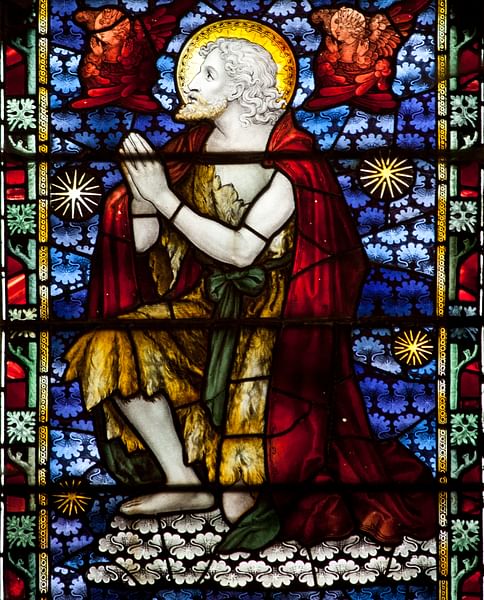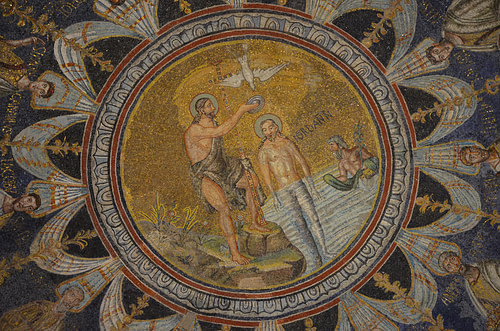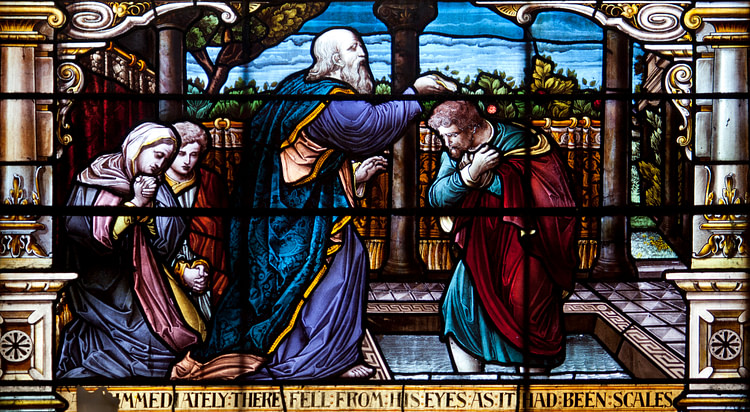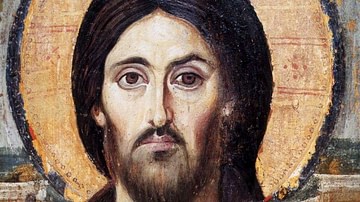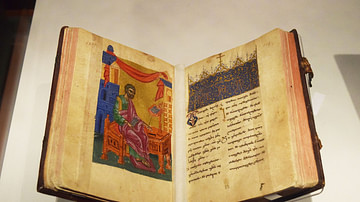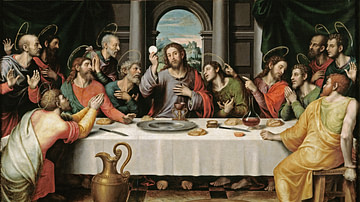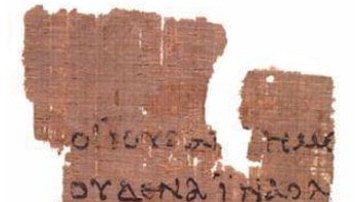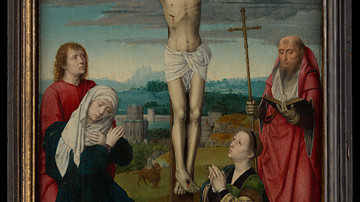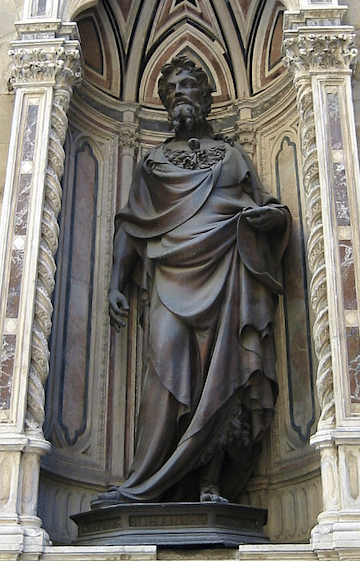
John the Baptist (d. c. 30 CE) was a 1st-century CE itinerant preacher in Judea. We do not know his full name, but he is recognized by his activity. 'Baptizer' (Greek: baptizo) was translated directly into English and meant 'to immerse' or 'plunge'. John immersed people in the river Jordan after they had repented of their sins. Next to Jesus of Nazareth and Paul the Apostle, John the Baptist is one of the most recognized persons in Christianity, and baptism became one of the first rituals practiced by Christians.
John achieved martyr status in the 4th century CE and is now deemed Saint John. In the trade for relics, John was popular, with several churches that still claim to have either his head or the right hand that baptized Jesus. Mandaean Christians in Iraq claim to be the surviving remnants of John the Baptist’s followers, where some of their teachings also merged with a Christian Gnostic sect known as Manichaeism. Christian communities throughout the world continue to utilize baptism as a fundamental element of the faith and John is honored as a pious prophet of God in Islam.
Josephus
John looms large in New Testament scholarship because we have a description of John from a non-Christian source. Flavius Josephus (37-100 CE) was a Jewish historian who wrote a history of the Jews. He was not a witness to John, but he utilized contemporary records and annals. The story of John the Baptist occurs in a digression in his history of Herod Antipas (Tetrarch of the Galilee, c. 4 BCE - 39 CE). Antipas was married to the daughter of King Aretas IV of Nabatea (r. c. 9 BCE - 40 CE), a kingdom located in Jordan (Petra). He then divorced her to marry Herodias, who had been married to his half-brother, Herod Philip I. From her name, she had a close kin relationship to these men who were her half-uncles. King Aretas went to war against Herod Antipas and defeated him. Josephus then added:
Now some of the Jews thought that the destruction of Herod's army came from God, and that very justly, as a punishment of what he did against John, that was called the Baptist. For Herod slew him, who was a good man, and commanded the Jews to exercise virtue, both as to righteousness towards one another, and piety towards God, and so to come to baptism; for that the washing [with water] would be acceptable to him. (Antiquities of the Jews, 18.5.2)
The reason for John’s death was because he had "a large following." Large crowds in Judea quite often led to riots, usually against the current government. Josephus described several other itinerant preachers at the time who had followers. The Roman government traditionally arrested the leader, executed him and as many of his followers as they could find. Herod killed John because he was afraid that Rome would think he could not control his province.
This story is important not only for attesting to the activity of John but also for the existence of a large audience. After his death, his followers gathered around his name and passed on his teachings and apparently the ritual of baptism.
The Four Gospels
All four of the gospels begin Jesus’ ministry with his baptism by John. This does not indicate four different sources for John; they utilized the first gospel, Mark, and added their own details. John’s baptism of Jesus in all four convinces scholars that:
- There must have been an early tradition that John had baptized Jesus.
- The story of John (his activities as well as his death) must have been well-known; people keep asking if Jesus was John come back from the dead;
- John’s followers were a problem for the followers of Jesus: "They said to him, ‘John’s disciples often fast and pray. . . but yours go on eating and drinking" (Luke 5:33).
John’s gospel hints at the competition between the groups: "Now Jesus learned that the Pharisees had heard that he was gaining and baptizing more disciples than John" (John 4:1-2). The traditions of John compelled the gospel writers to turn to the Jewish Scriptures to explain the connection between the two. Significantly, the gospels all emphasize the superiority of Jesus over John.
The Gospel of Mark
Mark (c. 70 CE) began his gospel with the baptism of Jesus and so scholars utilize it for the basic story of John:
The beginning of the good news about Jesus the messiah, the Son of God, as it is written in Isaiah the prophet: "I will send my messenger ahead of you, who will prepare your way"—a voice of one calling in the wilderness, 'Prepare the way for the Lord, make straight paths for him.'" And so, John the Baptist appeared in the wilderness, preaching a baptism of repentance for the forgiveness of sins. The whole Judean countryside and all the people of Jerusalem went out to him. Confessing their sins, they were baptized by him in the Jordan River. John wore clothing made of camel’s hair, with a leather belt around his waist, and he ate locusts and wild honey. And this was his message: "After me comes the one more powerful than I, the straps of whose sandals I am not worthy to stoop down and untie. I baptize you with water, but he will baptize you with the holy spirit." At that time Jesus came from Nazareth in Galilee and was baptized by John in the Jordan. Just as Jesus was coming up out of the water, he saw heaven being torn open and the Spirit descending on him like a dove. And a voice came from heaven: "You are my Son, whom I love; with you I am well pleased." At once the Spirit sent him out into the wilderness, and he was in the wilderness forty days, being tempted by Satan. He was with the wild animals, and angels attended him. (Mark 1:5-13).
Mark has conflated several messianic texts from the Prophets Isaiah and Malachi (3:1; 4.5) and images that evoked the Prophet Elijah. The physical description of John (the camel hair and eating locusts and honey) is related to the stories of Elijah (1 Kings 17-19 and 2 Kings 1-2 Kings). Elijah wore "a garment of hair and with a leather belt around his waist" (2 Kings 1:8). Mark’s description has become the favorite way in which to portray John in art and film.
The quote from the book of Malachi (c. 450 BCE?) claimed that Elijah, who had been taken to heaven without dying, would be sent by God as a herald "before that great and dreadful day" (Malachi 4:5) and would announce the coming of the messiah. In the transfiguration scene, Elijah appears to Jesus along with Moses, indicating the fulfillment of this prophecy (Matthew 17:1–8 Mark 9:2–8, Luke 9:28–36).
The holy spirit mentioned in the passage is not yet the Holy Spirit of the Trinity. This is the spirit of God (the 'breath of God' that 'possessed' the prophets). The dove is a symbol of God’s presence. Jesus is now endowed with the same spirit of the prophets so that he can perform miracles. Going to the wilderness is also an allusion to the prophets, who went to the wilderness somewhat like an apprenticeship to prepare for the mission.
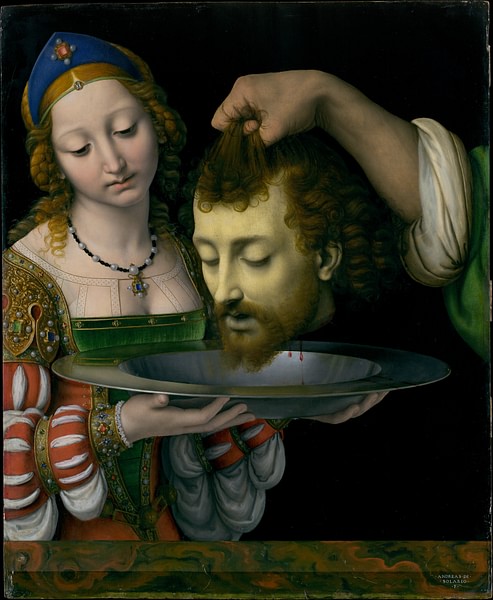
Mark reported the death of John halfway through the ministry of Jesus. In Mark’s version, the reason that John was arrested was that he criticized Antipas’ marriage to Herodias, "For John had been saying, 'It is not lawful to have your brother’s wife'" (Mark 6:18). This is the famous scene of Antipas’ birthday party, where his step-daughter danced for the guests and he offered her anything she wanted. At the urging of her mother, she asked for "the head of John the Baptist on a platter" (Mark 6:25). Mark did not name the daughter, but we know from genealogies that she was named Salome. Whereas Josephus had described John’s death as a political expedient, Mark, in keeping with his major theme of the gospel, had John die for religious differences among the Jews.
The Gospel of Matthew
It is notable that neither Josephus nor Mark described John as preaching about the imminent kingdom of God, which was the message of Jesus. Both have John baptizing people for "the remission of sins" as an overt sign of repentance. Matthew, in editing Mark, eliminated the line mentioning the remission of sins. Instead, he connected John to Jesus with the identical message: "In those days John the Baptist came, preaching in the wilderness of Judea, and saying, 'Repent, for the kingdom of heaven has come near'" (Matthew 3:1). John addressed the Pharisees and Sadducees as "You brood of vipers" (Matthew 3:7), reflecting Matthew’s favorite polemic against the authorities. This established the iconic image of John as a type of firebrand preacher working in tandem with Jesus, to prepare everyone for the coming kingdom.
Matthew’s John is reluctant at first: "But John tried to deter him saying, 'I need to be baptized by you, and do you come to me?' Jesus replied, 'Let it be so for now; it is proper for us to do this to fulfill all righteousness.' Then John consented" (Matthew 3:13-15). One of Matthew’s themes is that everything about Jesus, including John, fulfilled the Scriptures.
The Gospel of Luke
Luke’s gospel provided a biography for John, which is now standard in Christianity. The parents of John the Baptist were an old and barren couple who received divine intervention in the birth of a son. The angel Gabriel appeared:
Do not be afraid, Zechariah ... Your wife Elizabeth will bear a son and you will name him John. ... He must never drink wine or strong drink, even before his birth he will be filled with the holy spirit, ... with the spirit and power of Elijah ... to make ready a people prepared for the Lord. (Luke 1:1-18)
To drink no wine is a reference to what is known as a Nazirite vow (Numbers 6:2-4). Nazirite vows were taken by individuals to demonstrate sole devotion to God. Both Samson (Judges 13.4) and Samuel (1 Samuel 1:11) were children of divine promises to barren women. The Nazirite command against “using a razor on the head,” was what gave John his long hair and beard.
Luke’s Mary visited her cousin Elizabeth while they were both pregnant. This is the only source for the kinship between Jesus and John. As Mary approached Elizabeth, "the baby leaped in her womb" (Luke 1:41). For Luke, if anyone doubted who was superior, even in the womb, John recognized "his Lord" but note that the baptism of Jesus takes place off-stage in Luke, not directly.
Both Matthew and Luke include a scene during the ministry of Jesus which belies their opening stories: "When John heard in prison what the messiah was doing, he sent word by his disciples and said to him, 'Are you the one who is to come, or are we to wait for another?'" (Matthew 11; Luke 7). Jesus tells them to relate the miracles he has done, and then tells the crowd: "I tell you, among those born of women there is no one greater than John; yet the one who is least in the kingdom of God is greater than he" (Luke 7:28).
The Gospel of John
John opened his gospel with the famous preface that claimed that Christ was the pre-existent logos, "The Word became flesh and made his dwelling among us" (John 1:14) The Baptist serves mainly as a witness to this divine nature:
There came a man who was sent from God. His name was John. 7He came as a witness to testify about the Light, so that through him everyone might believe. 8He himself was not the Light, but he came to testify about the Light. (John 1:6-8)
John’s story of the Baptist contributed to later creedal formulas. In the fourth gospel, the crucifixion took place while the lambs were being slaughtered in the Temple for Passover. On the approach of Jesus, the Baptist said, "Look, the Lamb of God, who takes away the sin of the world!" (John 1:29). In the Catholic Church, the liturgy of the Eucharist culminates with this line from John.
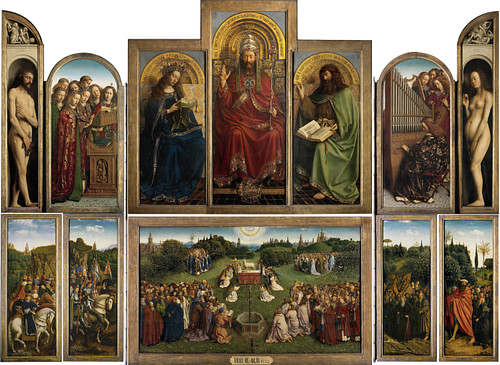
Historicity
The Greek baptizo is the Jewish concept of tvilah, or 'full body immersion'. Tvilah was required in relation to the purity/impurity for the maintenance of sacred space in the Temple in Jerusalem. The practice is attested in the archaeological ruins in Israel. Mikvahs (Hebrew for 'gathering of waters'), were sunken baths built into the bedrock, with steps leading down. They had to contain 'living water' (that is not stagnant), and the person immersed him or herself. Baptism came to mean simply dunking.
A historical anomaly remains in the story of John the Baptist. Neither Josephus nor the gospels explain why John was baptizing at the river Jordan when a water ritual of repentance was available at the Temple in Jerusalem. However, if he was a Nazirite, his zone of activity would be the desert. Combining John with the ministry of Jesus, the traditional understanding aligned John with the same anti-Temple attitude as assigned to Jesus in the gospels.
With the discovery of the Dead Sea Scrolls in 1947 CE and its information of the community of Essenes at Qumran, there have been several studies to determine if John may have been a member. The Essenes practiced baptism and were concerned with separating the 'pure' from the 'impure'. In the Community Rule, repentance preceded the receipt of the "holy spirit" (1Q III 8-9). They also criticized the Temple in Jerusalem harshly.
Baptism in the Early Christian Communities
Unfortunately, we have no documents written by the followers of John in this period. We know that an early follower of John or Jesus introduced it to the earliest Christian communities. Luke claimed that the practice began at Pentecost in Jerusalem. After the descent of the spirit on the disciples, "Peter replied: 'Repent and be baptized, every one of you, in the name of Jesus Christ for the forgiveness of your sins. And you will receive the gift of the holy spirit'" (Acts 2:38). In Acts, baptism in the name of Jesus carried proof that it worked: baptism endowed people with the gifts of the spirit; the room shook, people prophesied, and "spoke in tongues" (Acts 19:6).
The clash of the two groups is related in Acts 18 and 19. Paul’s traveling companions, Priscilla and Aquilla, ran into "a Jew named Apollos, a native of Alexandria, .... who only knew the baptism of John. ... [They] took him aside and explained the way of God to him more accurately" (18:24-27). Paul then went to Ephesus and met some who had been baptized into "John’s baptism" by Apollos but had not "received the spirit". Paul had to rebaptize them and this time, the "holy spirit came upon them, and they spoke in tongues and prophesied" (19:1-7).
We know Apollos existed because Paul mentioned him in 1 Corinthians. We have no further detail than this, but a correction by one group to another implies criticism. The ritual Luke described - confession, baptism, receipt of the spirit - became the norm in Eastern Orthodoxy and Western Catholicism as one of the sacraments accompanied by the spirit.
The story of Paul’s baptism only occurs in Acts 9:17-19, when a Christian named Ananias cured his blindness and baptized him. Paul himself never related his own baptism, but baptism is a main topic of his letters. Writing to the Roman community he used the analogy of death to describe what happened at baptism:
We are those who have died to sin; how can we who died to sin go on living in it? Or don’t you know that all of us who were baptized into Christ Jesus were baptized into his death? We were therefore buried with him through baptism into death in order that, just as Christ was raised from the dead through the glory of the Father, we too may live a new life. (Romans 6:1-4)
In other words, baptism was to bring a drastic change in one’s life, to sin no more. The earliest communities practiced adult baptism, which was done after a period of study (usually three years). The initiates, as a group, were baptized at Easter.
Infant Baptism
Infant baptism first arose in the 2nd century CE in North Africa, most likely because of high infant mortality rates. In the 4th century CE, Augustine of Hippo (354-430 CE) invented the concept of original sin, declaring that the first sin resulted in an introduction of lust into the Garden of Eden. As descendants of Adam and Eve, we all inherit this first sin on our souls through conception. Baptism became the ritual to wash away the original sin; without baptism, one could not reach heaven.
He also introduced an exorcism into the formula; Satan had to be renounced before baptism. Augustine permitted others to be sponsors of the infant’s spiritual education, introducing the practice of godparents. However, many modern Christian denominations continue to practice adult baptism, such as the Baptist Churches.
